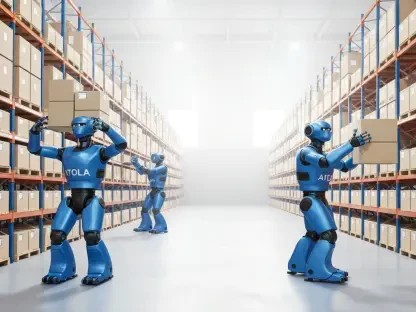In this engaging discussion, we sit down with Oscar Vail, a renowned technology expert with extensive knowledge in cutting-edge fields like quantum computing and robotics. With the impending launch of the Trump Mobile T1 Phone, which controversially claims to be “designed and built in the United States,” we delve into the credibility of these claims, the complexities of global supply chains, and the broader implications for the tech industry.
What are the initial claims made by the Trump Organization about the T1 Phone’s manufacturing origin?
The Trump Organization has boldly claimed that the T1 Phone is “designed and built in the United States.” They emphasize that it is a product for patriots, suggesting a departure from foreign manufacturing and an initiative to revive US phone production. They’re positioning it as a transformation in American tech manufacturing.
How likely is it that the T1 Phone is truly “designed and built in the United States”?
Given the existing supply chain dynamics, it’s highly unlikely that the T1 Phone meets the full criteria for being “designed and built in the United States.” Most experts agree that while some assembly might occur domestically, critical components are likely sourced internationally, possibly from China.
Can you explain the Federal Trade Commission’s standards for something to be labeled as “Made in USA”?
The Federal Trade Commission (FTC) holds strict standards for the “Made in USA” label. Essentially, all or almost all parts and processing of a product must be of domestic origin. In practical terms, this means that nearly every component and manufacturing process must happen within the United States, which is a significant challenge for tech products.
What strategies might the Trump Organization use to claim the T1 is “built in America”?
The organization could leverage the phrase “built in America” as opposed to “Made in USA,” which isn’t a regulated designation. This provides them some leeway to market the phone as American, despite potential foreign dependencies. Assembly or final finishes done stateside might be highlighted to bolster their claim.
How do experts view the possibility of the T1 Phone meeting the “Made in USA” standards?
Experts are skeptical about the T1 meeting these stringent standards. Many believe the phone will depend heavily on international supply chains. The consensus is that while parts of it may indeed be assembled in the US, the components are probably not sourced domestically.
What are the main reasons experts believe the T1 Phone will involve Chinese manufacturing?
The primary reason is the established infrastructure and capacity for component production in China. With decades of refined processes and cost efficiency, China remains a vital part of the global tech landscape. Shifting these operations to the US involves significant logistical and economic challenges.
How do supply chain constraints impact the feasibility of manufacturing phones entirely in the U.S.?
Supply chain constraints, like the availability of specific raw materials and specialized manufacturing processes, make fully domestic production nearly impossible. The U.S. lacks the complete infrastructure to produce every component of a smartphone, which necessitates reliance on global suppliers.
What challenges exist in creating an end-to-end tech supply chain in the U.S.?
Building a completely domestic supply chain would require huge investments in manufacturing facilities, technology, and skilled labor. A major hurdle is the shortage of workers with the required expertise, alongside the higher cost of labor compared to countries like China.
Why is the idea of making iPhones entirely in the U.S. considered unrealistic by experts?
Experts find it unrealistic due to the deeply entrenched global supply network that Apple utilizes. The shift would necessitate a massive overhaul of operations and logistics. Also, the cost implications would likely be passed on to consumers, making products less competitive.
How does the cost and availability of skilled labor in the U.S. affect phone manufacturing possibilities?
In the U.S., skilled labor is both less available and more expensive, which significantly impacts manufacturing possibilities. Even if supply chains were domestically established, labor costs would inflate production expenses, potentially making the products economically unfeasible.
What would be the broader implications for the global supply chain if more phones were made in the U.S.?
A shift toward U.S. manufacturing could disrupt current global supply networks, affecting numerous industries beyond just tech. It could lead to increased production costs, influence international trade relations, and force companies to reassess their global strategies.
Can you compare the T1 Phone to existing models based on the details we have?
From the specifications shared, the T1 Phone appears to be quite unusual. It features a 3.5mm headphone jack, which is increasingly rare in modern smartphones, and lists peculiar specifications like a “5000mAh long life camera,” which adds to the mystique but raises questions about practicality.
How does the complexity of a globalized tech world influence the production of smartphones like the T1 Phone?
The globalized nature of tech production allows for cost-effective and efficient manufacturing but introduces complexity in sourcing and production logistics. This complexity makes fully domestic production economically challenging, requiring businesses to optimize component sourcing worldwide.
What insights does Professor Tinglong Dai provide regarding domestic supply chains?
Professor Tinglong Dai highlights the challenges faced by domestic supply chains, noting that a fully self-sufficient tech supply network is currently unrealistic. He points out the interconnectedness of global supply systems and the vast network of countries involved in manufacturing even seemingly simple products.
What are the main takeaways from the ‘Mapping the iPhone’ infographic about global supply chains?
The infographic vividly illustrates the intricacy of tech supply chains, showing how numerous countries contribute to the production of iPhones. It underscores the notion that globalization is deeply embedded in tech manufacturing, with each component often traveling across many borders before assembly.
How might the label “assembled in the USA” be more accurate for the T1 Phone than “made in the USA”?
“Made in the USA” implies comprehensive domestic production, while “assembled in the USA” suggests that the final product construction occurs here, but the parts are sourced globally. For the T1, this latter label aligns more realistically with what experts predict about its production.
Are there any potential consumer reactions or market impacts anticipated for the T1 Phone’s launch in August?
Consumer reactions might be mixed; some may be drawn to the patriotic branding, while others might question the authenticity of the claims. Depending on its features and performance, it might stir curiosity but is unlikely to unsettle major players like Apple significantly.
What are some unique or unusual features of the Trump Mobile T1 Phone compared to other smartphones?
Besides the 3.5mm headphone jack, the T1 Phone includes bizarre features like a “5000mAh long life camera.” These deviations from standard specifications give it a unique character, although their practical benefits remain unclear.
Do you have any advice for our readers?
In navigating tech purchases, it’s vital to scrutinize claims and understand the context of manufacturing and supply chains. Look beyond marketing and investigate the features and origins of tech products to make informed decisions.









